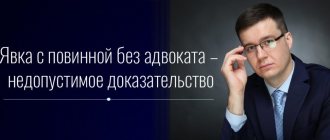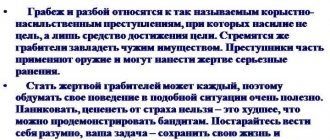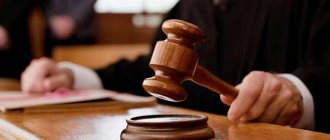In judicial practice, it is important to be able to distinguish truth from lies. In this area, the most common lie is to obtain benefits, for example, to avoid punishment. Since 2001, Russia began to accept the results of polygraph testing of participants in legal proceedings. In world practice, these studies have been used by various intelligence agencies and law enforcement agencies to obtain evidence of guilt for more than 80 years. To answer the question: “Is a lie detector evidence for the court?”, it is worth considering its use in judicial practice in more detail.
Lying is a simple matter and accessible to everyone, and yet I have never seen a liar who could successfully lie three times in a row. Jonathan Swift
Method for obtaining information by a polygraph examiner
Polygraph tests are a very powerful argument for many people, since the possibility of deceiving them is very small.
This device only reads information about the subject's reaction to a question, for example, increased heart rate or trembling in the fingers. The change in physiological response is read by the sensors of the device. The data obtained as a result of testing is processed by a polygraph examiner - only he is able to distinguish a reaction caused by a lie from natural excitement due to fear of examination or accusation. Therefore, when using a polygraph in court as evidence, it is important that the study is carried out by a qualified specialist.
Principles of legal proceedings
The dominant position, determining the nature and primary norms in court, is occupied by the principles prescribed in the articles of the Constitution of the Russian Federation and fixing the requirements for legal proceedings.
According to the law, the duty of the state is to protect and protect the interests and rights of both organizations and legal entities that have suffered from acts of a criminal nature or illegal and unfounded accusations, convictions and restrictions.
Legal proceedings must comply with:
- Legality of investigation and justice actions.
- Respect for the honor and dignity of a person.
- Inviolability of interests and private property.
- Organization for the protection of individual freedoms and rights.
- Maintaining the secrecy of correspondence, messages and negotiations.
- The presumption of human innocence.
- Rights to protection.
- Competitiveness of the parties involved.
- Freedom to obtain evidence.
- Freedom to choose the language of legal proceedings.
- The right to appeal procedural actions and decisions.
They receive constitutional and legal development and change along with the level of economic and social change in society.
The work of the polygraph in criminal proceedings corresponds to the stated principles of legal proceedings, is carried out according to a proven scheme and does not harm the health of the subject.
The document for the lawful use of the device was the Resolution adopted on May 17, 1996, which carried out a program to strengthen work with the eradication of crime from 1996 to 1997. It talks about the need to use a PFE device. Clause 2.1.6 stipulates the financial side for the development of a methodological basis and corresponding apparatus. To date, the instructions dated December 28, 1994 have been communicated.
The use of a technical device is specified by departmental regulations and instructions with designated access codes. The results are documented and taken into account when proving guilt.
On a special form, the person being interviewed signs an explanation of the points presented:
- the examination takes into account the consent of the citizen and his participation is confirmed by his personal signature;
- mandatory familiarization with the essence of the interrogative sentences being asked is required;
- a person has the right to change his mind about participating or postpone it to another time acceptable to him;
- the results are used exclusively within the organization interested in the experiment.
During the interview, the testing person uses only scientifically proven research. There are a number of cases where the courts of first instance accept evidence of this type of interrogation.
Is there always an opportunity for a polygraph test in court?
The polygraph is widely used to test people in a variety of settings, but it can be most useful during litigation. There are different types of courts:
- criminal; arbitration; civilian.
Most often, polygraph studies serve as evidence in criminal and administrative cases. When considering a case in court, both parties involved in the process may file a motion to order psychophysiological testing. Most often, this measure is used if only in this way, and in no other way, can one of the parties prove that they are right.
It is worth noting that the court does not always order a lie detector test. Why this happens, consider the options:
- When considering criminal cases, if the defense in order to prove innocence, most often the judge refuses to conduct it or the data obtained during the study have little influence on the final decision. A polygraph in court becomes a more powerful argument representatives of the prosecution file a petition for testing .
Polygraph as a method for diagnosing a person’s psycho-emotional state
A polygraph, in other words a “lie detector,” is a device that interacts with a person at the level of reaction to questions regarding a case being considered in court. A person can only answer “yes” or “no,” and the equipment notes his emotional outburst regarding each moment of the study. Before carrying out this procedure, the expert gets acquainted with all the materials of the case and draws up a list of questions that will be asked to the subject. The polygraph examiner’s questions are as follows:
- whether the person could have committed the actions that occurred during the crime;
- how aware a person is of the actions that occurred;
- what are the motives for the actions committed by the citizen.
Similar material: lawyer service.
Then, the specialist draws up his conclusion based on the data received, describes in it his opinion, which the judge can rely on when deciding on the guilt of the citizen. This examination method can be used not only with regard to the suspect, but also the victim and witnesses. They must give their written consent, since no one can force a citizen to forcibly agree to conduct any experiment.
In what cases is a polygraph used in court?
According to the legislation of the Russian Federation, in a court considering any type of case, each party can prove its case by any methods, except those prohibited by law.
Let us consider, for example, what the results of an examination conducted using a lie detector during the consideration of a criminal case provide. In relation to the accused, psychophysiological testing helps in cases where:
- There is no other direct evidence. The testimony of witnesses in court or other participants in the process contradicts what was established during the investigation. There are still unanswered questions in the case or contradictions that representatives of the prosecution or defense need to clarify in order for the court to make the right decision.
Can polygraphic research be evidence?
Regarding the issue of whether a polygraph is evidence in a criminal case, there are still disputes between lawyers, lawyers, round tables and conferences are being organized. Currently, is not accepted as evidence in a criminal case Many experts believe that the opinion of an expert can be quite subjective, so the question of guilt or innocence is decided only by the judicial body. This function is not within the competence of a printer, because this person has his own specialization of work, which is not related to the consideration of criminal cases.
Similar material: recognition as a victim in a criminal case.
and get free legal advice within 5 minutes.
*All fields are required
When can using a polygraph in court cause harm?
Testing using a polygraph does not always help the participants in the process who applied for it.
Let's look at an example:
In the Supreme Court, after the impossibility of a successful decision in one of the regional courts, one libel case was considered (before liability under the Criminal Code was returned). Two gentlemen M. and N participated in the civil process.
M., who started this trial, pointed to many witnesses who were ready to testify in his support. They were present at the moment when the accused N. repeatedly disseminated various information about M. They greatly spoiled the applicant’s reputation and the reputation of his business as a whole.
However, M., despite the full evidence base, lost the case due to the fact that he often petitioned for a psychophysiological examination using a lie detector to be carried out on his witnesses. Most of them did not want to participate in the process for this reason, because they considered this measure unnecessary or were unpleasantly surprised that M. did not trust their words and petitioned for an additional check.
The judge was unfavorable to M. due to the fact that he had to decide on a large number of applications submitted. Despite the seemingly winning positions, M. lost the process due to excessive litigiousness.
Based on the example, we can conclude that in a court case it is worth requesting a polygraph test only in the most extreme cases, when it is really necessary. It is not worth it to unnecessarily subject a witness who is already on your side, as M. did, because most people are very worried about such testing and do not want to subject themselves to such a test. It was for this reason that M. lost all his witnesses.
How is the data obtained using a polygraph used?
It is no secret that the opinion of forensic medical experts, lawyers, attorneys, and judges regarding the use of conclusions drawn up based on the results of a polygraph (lie detector) study in criminal trials is contradictory. The main question that arises when conducting such an event with the accused is: is a polygraph evidence in a criminal case ?
The answer to this question worries many, since with the help of such a device they evaluate the emotional state of a person and his reaction at a certain moment during an experiment with the presentation of information. A person under investigation who has nothing to do with crimes usually reacts evenly to the questions put to him, he is not overcome by excitement, and a state of neurosis does not appear.
Related article: statute of limitations in criminal law.
On the one hand, by involving information obtained from the study of psycho-emotional states using a printing apparatus in criminal cases, it could provide an almost indisputable truth, and therefore, establish with a high degree of accuracy whether a citizen is guilty or suspicions are unfounded.
On the other hand, it is necessary to consider the work of interrogators and investigators, since they conduct pre-trial proceedings, establish details, circumstances, motives, and identities of people involved in criminal activities. Their information may conflict with the information of the polygraph, then another question will arise - what information should be trusted, because some data are obtained mechanically, while others are obtained through practical methods.
In addition, such a term as evidence has its own characteristics, to which a polygraph as evidence in a criminal trial does not apply.
Related Article: Liability for Perjury.
What is a polygraph?
Nowadays, a polygraph or “lie detector” is a whole complex of devices consisting of:
- laptop with necessary software
- 5 – 8 sensors recording various physiological indicators
- in fact, the polygraph examiner himself, a person without whom it would be impossible to understand where the line between truth and lies is.
It is important to understand that the polygraph itself does not show anything . That is, he does not say: “This is true,” but here the person lied. It only measures biological changes in the human body.
But the answers themselves are given by a specialist polygraph examiner. And the results depend on how professional this person is.
How did the lie detector come about?
In ancient China, during the announcement of charges, the suspect was forced to take a mouthful of rice. If the grains remained dry after extraction, then the guilt was considered proven.
In India, during the “investigation”, he was given key words associated with the crime. Having heard them, the suspect had to immediately say any word that came to mind and kick the gong. At moments when the subject was lying, the gong was struck more powerfully.
At the end of the 19th century, the Italian physiologist Angelo Moss, while showing fear-inducing pictures to a patient, discovered that the subject’s heart rate increased. For these purposes, he used a plethysmograph , a device that helped determine the pulse rate.
William Marston is considered to be the true inventor of the polygraph . He devoted his life to the study of human behavior and the connection between humans and physiological processes. The topic of Marston's doctorate was the development of a test that could detect lies by measuring changes in systolic blood pressure.
Can you trust a polygraph?
A good polygraph examiner is the key to a successful and reliable test for truth and lies. This person must have good psychological training. Why? Yes, because he must know how to put pressure on a patient.
Using a test set of questions, a polygraph examiner determines how a particular person physiologically reacts to truth and lies. Some people's breathing quickens, but their pulse remains unchanged, while for others it's the opposite.
For example, during a test the same question may be asked several times. At the same time, its semantic essence remains the same, but the subject’s brain at this moment reacts to it differently.
The polygraph examiner’s task is to respond correctly to such surges in blood pressure and pulse. That is, the exact result essentially depends on one person.
But if he is a professional, then the percentage of test reliability according to statistics is about 95 - 98% .








